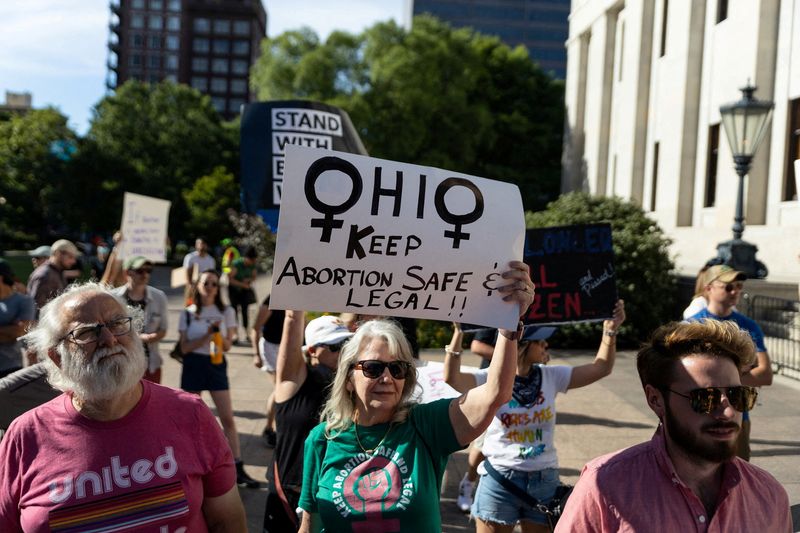
© Reuters. FILE PHOTO: An abortion rights protester holds a sign to keep abortion safe in Ohio at a rally in Columbus, Ohio, after the United States Supreme Court ruled in the Dobbs v Women’s Health Organization abortion case, overturning the landmark Roe v Wade abo
By Joseph Ax
(Reuters) -Ohio voters on Tuesday rejected a Republican-backed measure that would have made it harder to amend the state constitution, an initiative aimed at lowering the chances of passage for a November referendum that would protect abortion access statewide.
The results in the special election were a crucial victory for abortion rights advocates, who would have faced the daunting prospect of securing a super-majority of voters this fall if the measure had passed.
The proposal, known as Issue 1, would have lifted the threshold for passing future changes to the state constitution to 60% of voters, up from 50%, as well as imposing more stringent standards for getting such measures on the ballot in the first place.
With more than 1.2 million votes counted, 60% of Ohioans had voted no, compared with 40% who voted yes, according to the Ohio secretary of state’s office. That margin was enough for Decision Desk HQ and the Associated Press to call the race.
The election was the latest statewide battle over abortion more than a year after the U.S. Supreme Court eliminated a nationwide right. Advocacy groups on both sides of the abortion issue spent millions of dollars ahead of Tuesday’s vote.
Ballot initiatives have become powerful tools for abortion rights activists in states where abortion opponents, usually Republicans, control the legislature or hold the governor’s office.
Voters in Kansas and Kentucky, both solidly conservative states, rejected measures last year that would have declared that their state constitutions do not protect abortion rights.
On Tuesday, abortion rights groups in Arizona, a key presidential swing state, launched an effort to put the issue before voters in November 2024.
Republican Ohio Governor Mike DeWine signed a six-week abortion ban into law in 2019, which went into effect following the Supreme Court’s decision. The ban was put on hold in September after a legal challenge from abortion clinics; the Ohio Supreme Court has agreed to decide the case.
Some groups opposed to Tuesday’s ballot question had emphasized that the referendum went beyond abortion, arguing it is simply undemocratic to curb citizens’ power.
“This is much larger than one issue; it’s much larger than one party or one election,” said Jen Miller, the executive director of the League of Women Voters of Ohio. “This is about a freedom that Ohioans have had for more than a century.”
For instance, good government groups are working on a ballot question for 2024 that would amend the constitution to prevent gerrymandering, the process by which one party manipulates district lines to entrench power. If Tuesday’s referendum had succeeded, getting that issue on the ballot would be far more challenging.
Last year, Ohio Republicans drew sharply partisan state legislative and congressional maps and defied court orders to revamp them; November’s elections were held using maps that had been ruled unconstitutional.
Abortion rights opponents have called the November referendum extreme, claiming its vague language would allow minors to get abortions and gender-affirming surgery without parental consent.
Supporters note the amendment makes no mention of gender-affirming treatment or parental consent.
Tuesday’s election drew millions in outside spending, including from so-called “dark-money” groups that are not required to disclose their donors.
Illinois Republican mega-donor Richard Uihlein donated at least $4 million to the pro-Issue 1 campaign, according to campaign filings. Other groups supporting Tuesday’s referendum collected funds from Susan B. Anthony Pro-Life America and The Concord Fund, a conservative dark-money group.
The anti-Issue 1 side got support from the Tides Foundation, a California-based social justice organization, and the Sixteen Thirty Fund, a liberal dark-money group.








